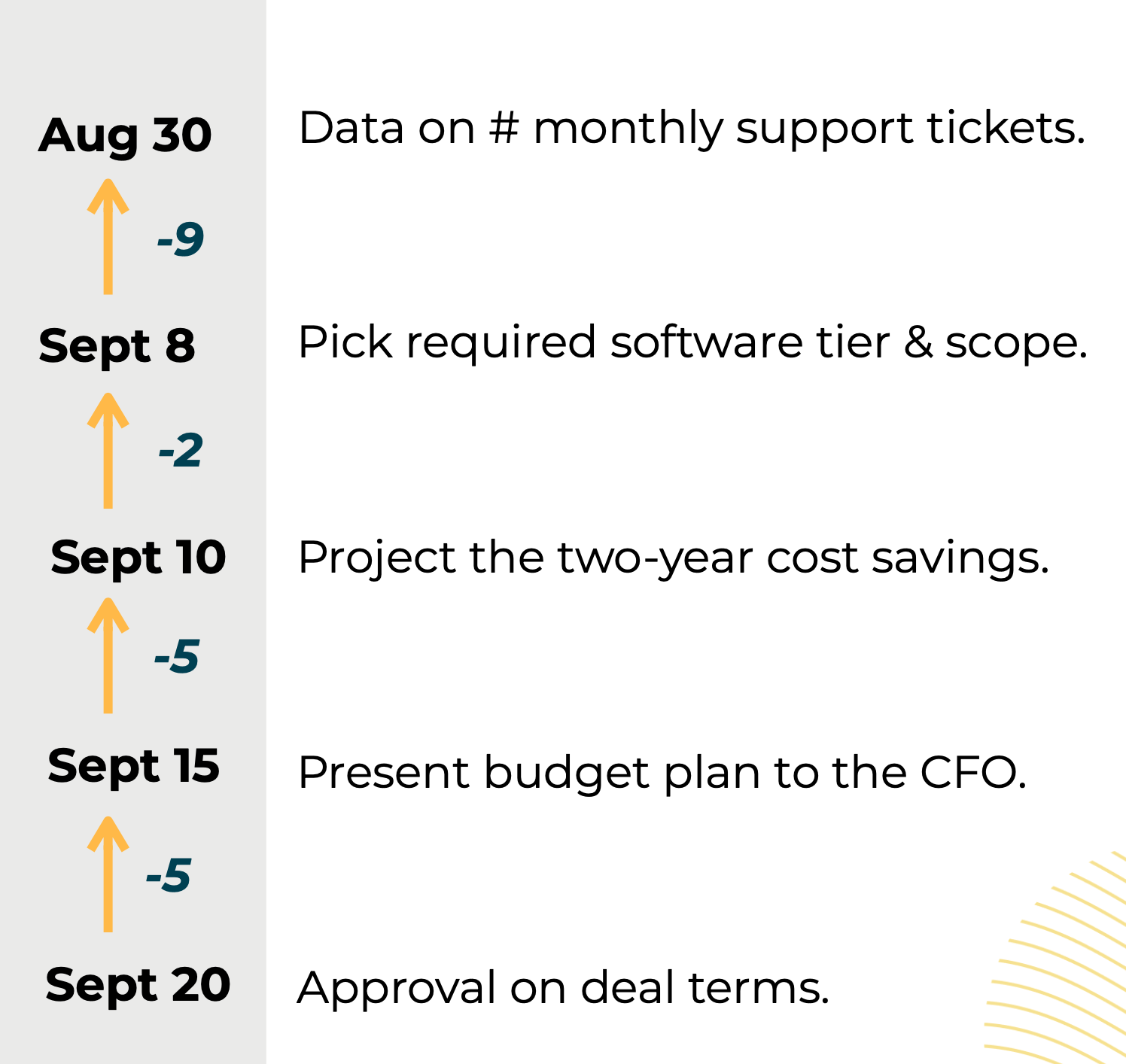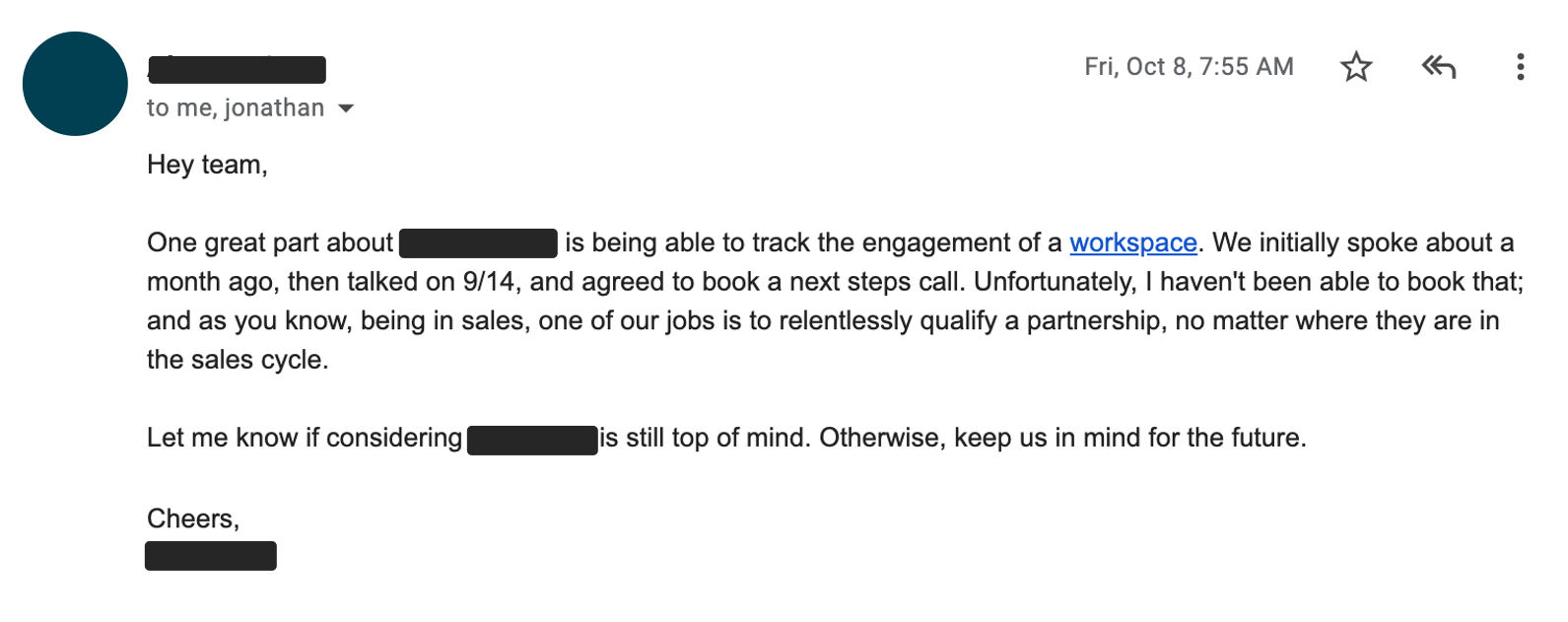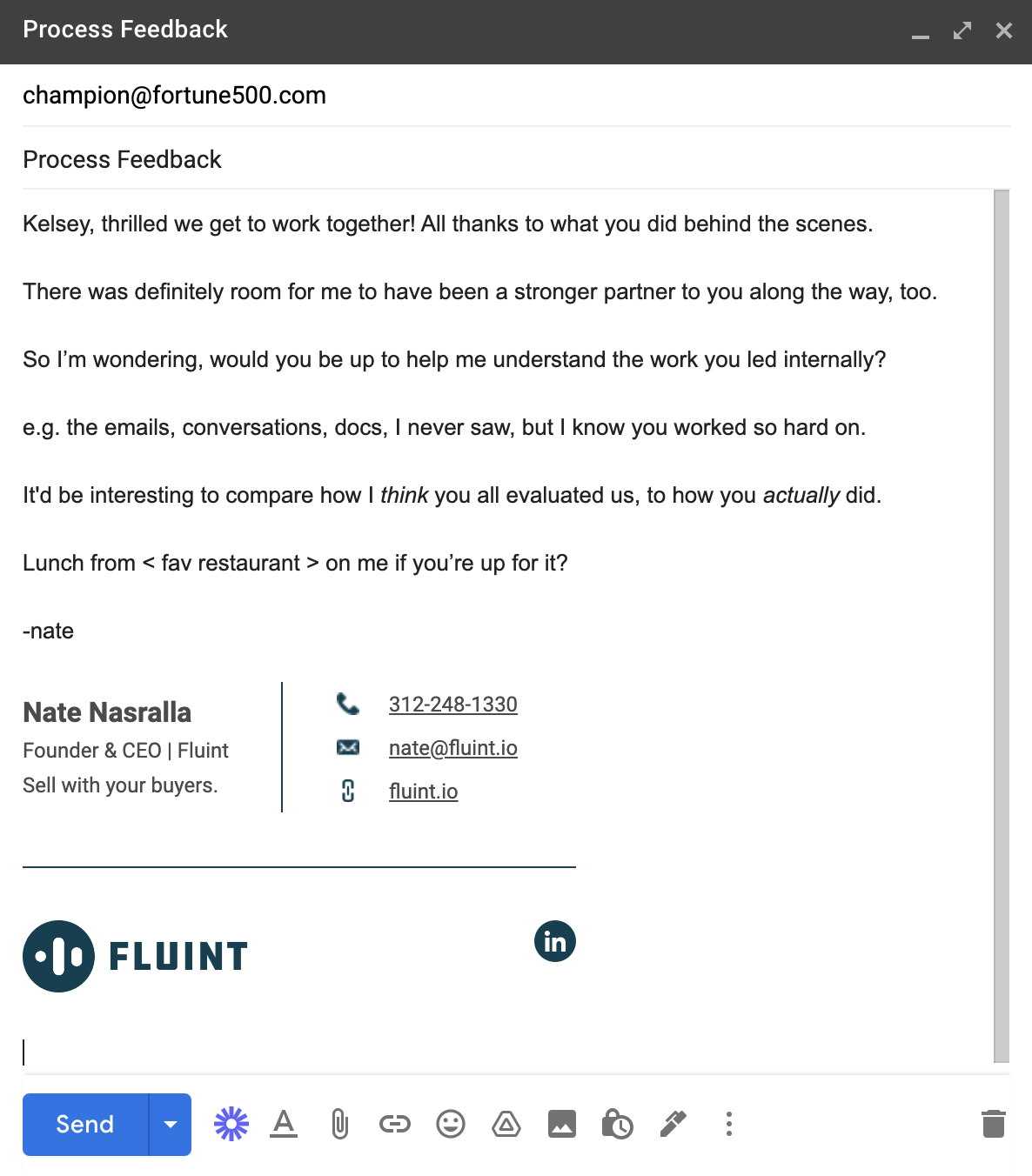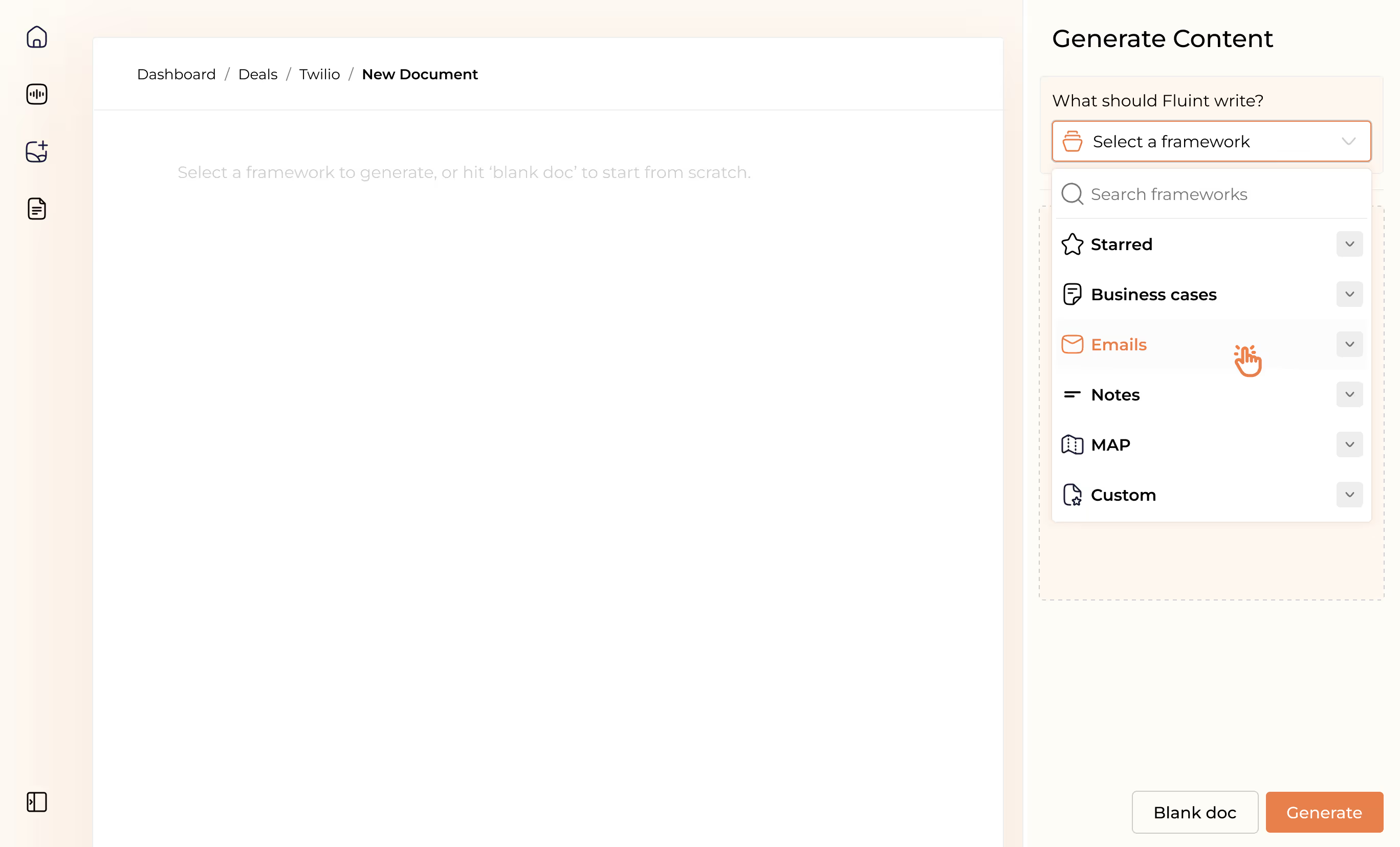How to Build Mutual Action Plans Your Buyers Actually Follow Through With


Sales reps typically see low or no engagement from buyers while introducing Mutual Action Plans (MAPs). And honestly, I wouldn’t engage with MAPs in the way they’re often used, either.
So in this post, we’ll break down:
- What most reps miss about MAPs.
- How to build and introduce MAPs strategically.
We'll start with three observations from the buyer’s perspective. To help put MAPs in the context of everything you’re reading about selling with champions on this blog.
Here’s how a Senior DevOps Director — who manages $2M of spend for developer tools — framed up the topic with me. I'll just label him "buyer" here.
This is a long transcript excerpt, but it's worth reading in its entirety:
Nate: “So how do you think about the different materials sales reps have created to help you in the buying process?”
Buyer: “Like documents and decks and that sort of thing?
Nate: “Right. Exactly.
Buyer: “So a new one I’ve been seeing is like a project plan. Where we lay out the steps for the purchase. And it's helpful for me to see what’s involved from their perspective, because I’m going to match up the level of effort I’m seeing they need, to how important I think this project is.
It lets me be realistic with the rep about where I’m at, and just how interested I am in going on this journey with them. Then if I am interested, that doc isn’t going to help me get others interested. I can’t just bring a bunch of tasks to my CTO and be like, 'Here, look at this.'
He’ll be like, 'What the h*ll is this for? What’s the point of it?' So it’s not really something I use with leadership. That’s where I’m writing up what we call a decision memo.
Something that says, 'Hey, this is a big deal for us, we need to address it.' The content for that is, honestly, up to me. I haven’t found many reps to be helpful here.”
Nate: “Why’s that? I mean, why do you think reps haven’t been helpful with that memo?”
Buyer: “Well because they don’t really know what my executives are thinking about. I guess that might be on me to enlighten them, but I find most of what I get from them is focused on their product. And honestly, it’s pretty common that my CTO won’t even see the thing they’re signing off on."
Nate: “Got it, so then what would you ideally want the sales rep to focus on with you first? The project plan, or that memo?”
Buyer: “Well after leadership’s already sold on the idea and what we’re looking to solve for, then I might give him a real quick glance of a project plan to basically say, 'we’re not gonna just wing it here.'
So that memo comes first in our internal process. I need people to see the need, and get the right people to the table. And that’s really the trick. If I can do that, it’s a matter of time and making sure the details and math all works out.”
There are three key points he raises here that most reps miss about MAPs:
What Sales Reps Miss About MAPs
1/ First, MAPs get used in place of crafting a business case.
Which is a huge miss, because they have very different purposes. Here's the difference:
- The “Decision Memo” answers “why?”
This is your narrative-style business case framing a costly problem blocking a strategic priority, while recommending an approach to unlock a specific set of outcome metrics.
- The “Project Plan” answers “how?”
This is your backdated series of tasks, owners, and deadlines, showing the level of effort and tactics to move from a problem to a payoff, once “sold” on the above.
2/ Second, this means the sequence of introducing each document is important.
Most reps jump right into the tactics of “how,” before aligning on the higher-order question of “why?” Which is out of order.
Once the buying team is sold on the destination, then, a MAP will help the buying team decide if they're up for the journey:
Does the level of effort needed align with the level of value my buyers see, as compared to other priorities they could be spending time on?
3/ Third, because each type of doc has a separate purpose, they also have different audiences:
- MAPs are built with champions and “doers” on the buying team.
- Business Cases target executives and high-influence contacts.
In short, you need both documents.
You already know how to craft internal narratives. So let’s talk about building and introducing MAPs in a way buyers will engage with them.
5 Steps to Build and Use Mutual Action Plans Buyers Actually Engage With
1. Layout your customers’ typical buying process.
Make a list of every step from agreeing there’s a problem, through onboarding and adoption, unique to your product.
Selling cybersecurity software? There’s likely some more intensive IT and Security steps than another buying process. Some more specific steps to consider are:
- Security: How long does the typical review take? Who’s involved?
- Legal: Will you start with your contract, or theirs? What are standard terms? How long will redlines take?
- Procurement: Would something trigger a competitive RFP? How do vendor requirements compare to you? How are these reviewed, and with who? How long does it take?
- Finance: How will budget be created? Will finance get involved? If so, when, and how do they review new requests?
A big mistake to avoid here is stopping at closed-won. That’s a “Close Plan,” not a MAP.
Remember, for your champion and their team, the customer journey begins after the contract. You’re getting them to the starting line. Not the finish.
2. Organize your list into a simple grid.
Major projects that our product team works on are organized into “epics.” Epics are larger milestones that need input from multiple people, broken down into a smaller set of tasks.

For example, “Create Budget” may be one epic with the tasks:
- Share data on the number of monthly support tickets.
- Project two-year cost savings and pick a software tier.
- Present savings and budget plan to the CFO.
- Sign off on payment amount and structure.
Next, since this is a mutual plan, split out the tasks between your own team — you, your executives, sales engineers, customer success, etc. — as well as the buying team.
Each task should have a DRI — “Directly Responsible Individual” — and a deadline.
Think about a simple spreadsheet, with the list of tasks running vertically in rows, with owners, deadlines, and notes running horizontally in columns.
The reason I say “simple” is the idea introduced in the excerpt above: return on effort.
If your list seems too long and complex, even if the tasks are relatively easy, then the perceived level of effort will be too high. Which drops the ROE: “return on effort.”
However, you don’t want to skip steps to make the process seem easier than it actually is. That’s how you end up sinking too much time into a dead-end deal.
3. Adapt your baseline with your champion’s feedback.
Now, you’ve got a baseline MAP. Something you can introduce in a conversation with your champion. Share it during a call and ask what you should adapt:
Here’s the process we typically see customers using to go live and make sure everyone’s on the same page.
How does this compare to any past purchases you’ve made?
It’d be great to cut what you don’t think applies, and add anything I’ve missed.
If your champion spearheaded a past purchase, they’ll have more detailed feedback here.
If they haven’t, ask them what in the MAP is surprising to them.
Which can help reveal where you’ll either need to educate them on why that step is important, or, edit the plan after discussing.
4. Work backwards from a compelling event.
We said each step needs a deadline. These deadlines, and the length of time needed for a task, lets you know how far ahead of a “compelling event” you need to start a task.
Compelling events are rooted in a time-bound need or goal that already exist inside the account. It’s a date you discover with your buyers. Not something you can manufacture as a seller.
For example:
- New product launches communicated in a press release.
- Holiday shopping seasons bringing a rush of site traffic.
- Use-it-or-lose-it budget scenarios. (The seller’s dream.)
If you have 90 days worth of tasks, and a holiday season 90 days away, well then, giddy up.
5. Use maps strategically, not administratively.
Too many reps see MAPs as a source of permission to send reminders.
Like, “Hey, you said you’d do X by today, and you didn’t, so I’m following up.”
They devolve into an administrative hassle, not a strategic asset, for the buyer.

Use MAPs more strategically with your champions by looking for:
- Common sources of friction.
Look at MAPs across all deals in your pipeline. If most deals slow down at a certain step, proactively suggest: “Hey, this is where the process tends to go off the rails. How could we keep the team motivated this week?”
- Specific owners who keep dropping the ball.
If you’re off track because a certain owner or team is consistently behind on following through, call this out: “It seems like < owner > is either swamped, or uncertain of the plan here. How do you think we should address that?”
- Opportunities to work as a team.
Shift and share tasks that are pacing behind. For example, if you see your champion struggling to get a conversation with Finance on the books, ask: “Hey, how about I draft that email for finance with our cost projections, for you to forward on?”
Finally, try using the “Process Feedback” email inside these 12 mid-funnel emails with your past champions, to build out the baseline MAP you’re starting from:

FAQ's on:
Why stop now?
You’re on a roll. Keep reading related write-up’s:
Draft with one click, go from DIY, to done-with-you AI
Get an executive-ready business case in seconds, built with your buyer's words and our AI.

Meet the sellers simplifying complex deals
Loved by top performers from 500+ companies with over $250M in closed-won revenue, across 19,900 deals managed with Fluint

Now getting more call transcripts into the tool so I can do more of that 1-click goodness.



The buying team literally skipped entire steps in the decision process after seeing our champion lay out the value for them.


Which is what Fluint lets me do: enable my champions, by making it easy for them to sell what matters to them and impacts their role.








